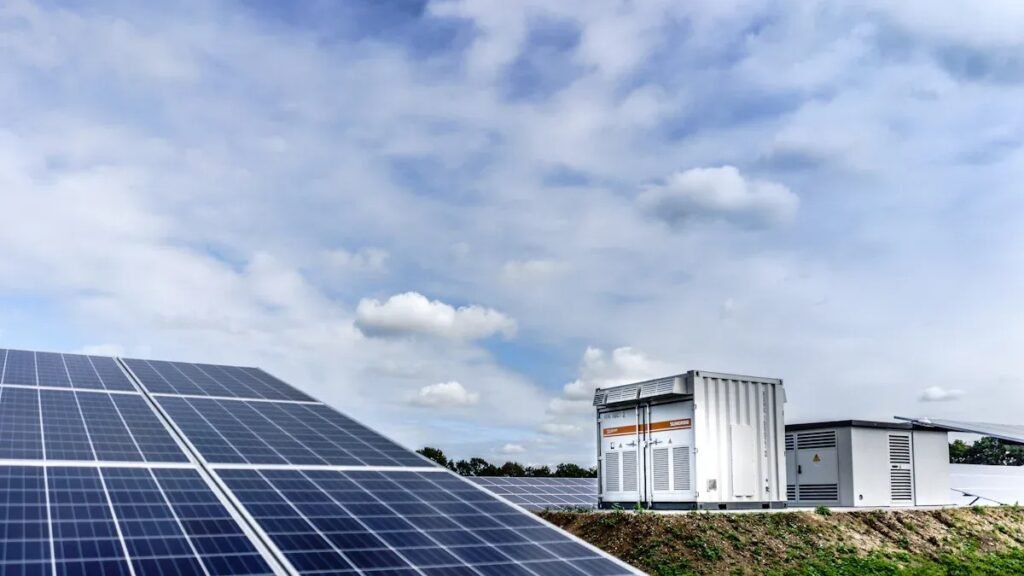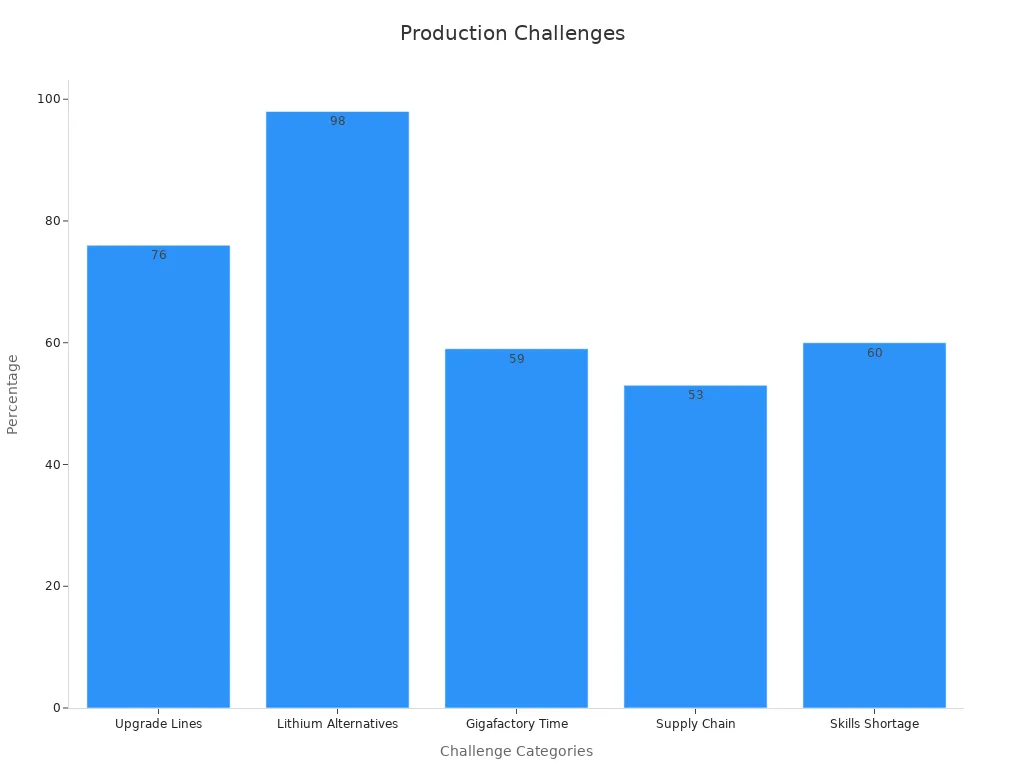Exploring the Future of Lithium-Free Batteries in 2025

Energy storage plays a key role in shaping a sustainable future. Lithium-free batteries offer a promising alternative by addressing some of the limitations of traditional lithium-ion technology. These batteries rely on abundant materials, making them a smarter choice for the planet. In 2025, groundbreaking innovations are pushing these technologies closer to mainstream adoption. You can expect safer, more affordable, and eco-friendly solutions that redefine how energy is stored and used.
Key Takeaways
- Lithium-free batteries use common materials like sodium and aluminum. This helps save rare resources and supports the environment.
- These batteries are safer because they don’t use flammable parts. They are a good choice for electric cars and green energy.
- Using lithium-free batteries can cost less since materials are cheaper. This makes them useful for big projects.
- New battery ideas, like solid-state and sodium-ion types, store more energy. They also last longer and work better.
- Switching to lithium-free batteries helps the planet by reducing harm. It also encourages recycling and protects nature.
Why Lithium-Free Batteries Matter
Addressing Resource Scarcity
The materials used in traditional batteries, like lithium and cobalt, are becoming harder to source. The demand for lithium has skyrocketed due to the growth of electric vehicles and energy storage systems. This has created a race to secure stable supplies. For example:
- Lithium prices surged over 400% between 2021 and 2022, showing how scarce and volatile this resource has become.
- Over 70% of cobalt production comes from the Democratic Republic of Congo, making the supply chain vulnerable to disruptions.
- Global lithium demand is expected to triple by 2035, putting even more pressure on these limited resources.
Lithium-free batteries, on the other hand, rely on materials like sodium and potassium. These elements are abundant and widely available, ensuring a more stable and cost-effective supply chain. By choosing these alternatives, you can help reduce the strain on scarce resources while supporting a more sustainable future.
Reducing Environmental Impact
Mining for lithium and cobalt has significant environmental consequences. It often leads to habitat destruction, water pollution, and high carbon emissions. For instance, lithium extraction requires large amounts of water, which can deplete local water supplies in arid regions. Cobalt mining, meanwhile, has been linked to deforestation and toxic waste.
Lithium-free batteries offer a cleaner solution. Materials like sodium and aluminum are easier to extract and process, resulting in a smaller environmental footprint. By adopting these technologies, you contribute to reducing the ecological damage caused by traditional battery production.
Overcoming Safety Concerns
Traditional lithium-ion batteries come with safety risks, including overheating and the potential for fires or explosions. These issues arise from the flammable liquid electrolytes used in their design. Lithium-free batteries, such as solid-state or sodium-ion batteries, eliminate many of these risks. They use safer materials and more stable chemistries, making them less prone to thermal runaway.
With these advancements, you can enjoy peace of mind knowing that lithium-free batteries prioritize safety without compromising performance. This makes them an ideal choice for applications where reliability is critical, such as electric vehicles and renewable energy systems.
Breakthroughs in Lithium-Free Battery Technologies

Solid-State Batteries
Solid-state batteries represent a major leap forward in energy storage. Unlike traditional lithium-ion batteries, they use solid electrolytes instead of liquid ones. This design improves safety and boosts performance. You can rely on these batteries for higher energy density, longer lifespans, and reduced risks of overheating or fires.
Here’s a closer look at their key performance metrics:
| Metric | Value |
|---|---|
| Energy Density | >1000 Wh L−1 |
| Capacity of Li metal | 5 mAh cm−2 |
| Cycling Stability | Stable over 50 cycles |
| Coulombic Efficiency | Near 100% |
| Initial Capacity | 0.8 mAh cm−2 |
| Capacity Fade | Observed after 50 cycles |
These batteries are ideal for applications like electric vehicles and renewable energy systems. Their ability to deliver high energy density makes them a game-changer for industries that demand efficient and reliable power solutions.
Tip: Solid-state batteries are safer and more stable than traditional lithium-ion batteries, making them a smart choice for future energy storage needs.
Sodium-Ion Batteries
Sodium-ion batteries offer a practical alternative to lithium-ion technology. Sodium is over 500 times more abundant than lithium, making these batteries more affordable and sustainable. You can expect faster charging speeds and a lifecycle three times longer than lithium-ion batteries.
| Feature | Sodium-Ion Batteries | Lithium-Ion Batteries |
|---|---|---|
| Abundance | More than 500 times more abundant | Limited availability in a few countries |
| Charging Speed | Charges faster than lithium-ion variants | Slower charging speed |
| Lifecycle | Three times higher lifecycle | Standard lifecycle |
Additionally, sodium-ion batteries are compatible with existing lithium-ion manufacturing infrastructure. This compatibility allows manufacturers to scale production quickly without significant changes to their processes.
- Increased abundance and availability of sodium suggest lower prices.
- Drop-in compatibility with existing lithium-ion manufacturing infrastructure allows for rapid scaling.
These batteries are perfect for grid-scale energy storage and other applications where cost and scalability matter most.
Magnesium-Ion Batteries
Magnesium-ion batteries are another promising option in the realm of lithium-free batteries. Magnesium is widely available and less expensive than lithium. It also offers higher volumetric energy density, which means you get more power in a smaller space.
You’ll appreciate the safety advantages of magnesium-ion batteries. They don’t rely on flammable electrolytes, reducing the risk of fires or explosions. Their stable chemistry makes them suitable for high-demand applications like electric vehicles and portable electronics.
Magnesium-ion technology is still in the early stages of development, but researchers are optimistic about its potential. As advancements continue, these batteries could become a key player in the transition to sustainable energy solutions.
Aluminum-Ion Batteries
Aluminum-ion batteries are emerging as a strong contender in the race for advanced energy storage solutions. These batteries use aluminum, a material that is abundant, inexpensive, and recyclable. This makes them an attractive option for industries seeking cost-effective and sustainable alternatives to lithium-ion technology.
You’ll find aluminum-ion batteries particularly appealing due to their impressive performance characteristics. They recharge faster, last longer, and require less maintenance compared to traditional lithium-ion batteries. These features make them ideal for applications like renewable energy storage and industrial microgrids. For example:
- The aluminum-ion battery market is expected to grow from USD 5.6 billion in 2025 to USD 9.5 billion by 2035, with a compound annual growth rate (CAGR) of 5.5%.
- Their longer shelf life and lower maintenance costs reduce operational expenses over time.
- Faster recharge cycles make them suitable for high-demand environments, such as solar energy storage systems.
Aluminum-ion batteries also offer significant scalability advantages. Their reliance on widely available materials ensures a stable supply chain, which helps manufacturers scale production efficiently. This scalability is crucial for meeting the growing demand for energy storage in sectors like transportation and renewable energy.
Note: Aluminum-ion batteries are not only cost-effective but also environmentally friendly. Their recyclability and minimal reliance on rare materials make them a sustainable choice for the future.
Experimental Chemistries
The field of lithium-free batteries continues to evolve, with researchers exploring experimental chemistries that could redefine energy storage. These cutting-edge technologies aim to overcome the limitations of existing solutions while pushing the boundaries of performance and sustainability.
One promising area of research involves dual-ion batteries. These batteries use both the anion and cation in the electrolyte to store energy, which increases their energy density. You’ll appreciate their potential to deliver higher performance without relying on scarce materials like lithium or cobalt.
Another exciting development is the use of organic materials in battery design. Organic batteries replace traditional metal-based electrodes with carbon-based compounds. This innovation reduces environmental impact and opens the door to fully biodegradable energy storage solutions. Imagine a future where your batteries decompose naturally, leaving no harmful waste behind.
Researchers are also investigating hybrid chemistries that combine the best features of multiple battery types. For instance, combining the high energy density of solid-state batteries with the affordability of sodium-ion technology could create a versatile and cost-effective solution. These hybrid designs aim to balance performance, safety, and scalability, making them suitable for a wide range of applications.
Tip: Keep an eye on experimental chemistries. They represent the cutting edge of battery innovation and could lead to breakthroughs that transform how you store and use energy.
Benefits of Lithium-Free Batteries

Improved Safety and Stability
You can trust lithium-free batteries to deliver safer energy storage solutions. Traditional lithium-ion batteries often face risks like overheating, which can lead to fires or explosions. These issues arise from the flammable liquid electrolytes used in their design. Lithium-free batteries, however, use stable materials and advanced chemistries that minimize these dangers.
For example, solid-state and sodium-ion batteries replace liquid electrolytes with solid or non-flammable alternatives. This change reduces the risk of thermal runaway, a condition where a battery overheats uncontrollably. Magnesium-ion and aluminum-ion batteries also offer enhanced stability due to their non-reactive materials.
Did you know? Lithium-free batteries are less likely to degrade under extreme conditions, making them ideal for applications like electric vehicles and renewable energy systems.
By choosing lithium-free batteries, you prioritize safety without sacrificing performance. This makes them a reliable option for powering your devices and systems.
Cost and Scalability Advantages
Lithium-free batteries provide significant cost benefits. Materials like sodium, magnesium, and aluminum are abundant and inexpensive compared to lithium and cobalt. This abundance ensures a stable supply chain, which helps keep production costs low.
Here’s how these batteries compare in terms of cost and scalability:
| Feature | Lithium-Free Batteries | Lithium-Ion Batteries |
|---|---|---|
| Material Availability | Abundant and widely available | Limited and geographically concentrated |
| Production Costs | Lower due to cheaper materials | Higher due to rare materials |
| Scalability | Easier to scale production | Challenging due to resource constraints |
You’ll also appreciate how lithium-free batteries can integrate with existing manufacturing infrastructure. For instance, sodium-ion batteries can be produced using the same facilities as lithium-ion batteries. This compatibility reduces the need for costly upgrades, allowing manufacturers to scale production quickly.
By adopting lithium-free batteries, industries can meet growing energy demands without breaking the bank. This affordability makes them a practical choice for large-scale applications like grid storage and transportation.
Environmental Sustainability
Lithium-free batteries offer a greener alternative to traditional energy storage. Mining for lithium and cobalt often harms the environment, causing deforestation, water pollution, and habitat destruction. In contrast, materials like sodium and aluminum are easier to extract and process, resulting in a smaller environmental footprint.
You can also count on these batteries to support recycling efforts. Many lithium-free chemistries, such as aluminum-ion batteries, use recyclable materials. This reduces waste and promotes a circular economy.
Tip: Switching to lithium-free batteries helps reduce your carbon footprint and supports sustainable energy practices.
Additionally, experimental chemistries like organic batteries aim to create biodegradable energy storage solutions. Imagine a future where your batteries decompose naturally, leaving no harmful waste behind. By choosing lithium-free batteries, you contribute to a cleaner and more sustainable planet.
Applications Across Industries
Lithium-free batteries are transforming how energy is stored and used across various industries. Their unique properties make them suitable for applications ranging from transportation to renewable energy systems. Let’s explore how these batteries are driving innovation in key sectors.
Transportation
You’ll find lithium-free batteries making significant strides in the transportation industry. Solid-state batteries, for example, are becoming a preferred choice for electric vehicles (EVs). Their high energy density and faster charging capabilities address two major concerns for EV users: range anxiety and charging time. These batteries also enhance safety, reducing the risk of overheating or fires during operation.
Magnesium-ion and aluminum-ion batteries are also gaining attention for their potential in lightweight vehicles like drones and e-bikes. Their stable chemistries and cost-effective production make them ideal for smaller, high-performance applications. By adopting these technologies, the transportation sector can move closer to achieving zero-emission goals.
Renewable Energy Systems
Renewable energy systems rely on efficient storage solutions to manage the intermittent nature of solar and wind power. Lithium-free batteries, such as sodium-ion and iron-air batteries, are stepping up to meet this challenge. Sodium-ion batteries are particularly well-suited for grid-scale energy storage. Their abundance and cost-effectiveness make them a practical choice for large-scale renewable energy projects.
Iron-air batteries, on the other hand, excel in industrial backup systems. These batteries offer long-duration energy storage at a fraction of the cost of traditional solutions. While their slower charge rates may limit some applications, their sustainability and affordability make them a valuable asset for renewable energy grids.
Industrial and Commercial Infrastructure
In industrial and commercial settings, reliability and safety are paramount. Zinc batteries are emerging as a robust solution for backup power systems. Their recyclability and low cost make them an attractive option for businesses looking to reduce operational expenses. These batteries also perform well in harsh environments, ensuring uninterrupted power supply during outages.
Solid-state batteries are another contender in this space. Their compact design and enhanced longevity make them suitable for powering consumer electronics and industrial equipment. You’ll appreciate how these batteries combine performance with safety, making them a versatile choice for various commercial applications.
Comparative Overview
Here’s a quick look at how different lithium-free battery types are being used across industries:
| Battery Type | Applications | Benefits | Challenges |
|---|---|---|---|
| Sodium-ion Batteries | Grid-scale energy storage, Stationary renewable energy systems | Abundant resources, Cost-effective production, Enhanced safety, Longevity | Energy density, Emerging technology |
| Zinc Batteries | Grid-scale energy storage systems, Backup power for industrial and commercial infrastructures | Abundance, Cost savings, Safety, Recyclability | Energy density, Performance issues |
| Solid-State Batteries | Electric vehicles, Consumer electronics, Renewable energy systems | Enhanced safety, Improved longevity, Faster charging | High costs, Material constraints |
| Iron-Air Batteries | Renewable energy grids, Industrial backup systems | Cost-effective, Sustainability | Slower charge rates |
This table highlights the versatility of lithium-free batteries across sectors. Each type offers unique advantages tailored to specific needs, from cost savings to enhanced safety.
Tip: When selecting a battery for your application, consider factors like energy density, cost, and safety to find the best fit for your needs.
By leveraging lithium-free batteries, industries can achieve greater efficiency, sustainability, and reliability. These advancements are paving the way for a cleaner and more resilient energy future.
Challenges in Adoption
Scaling Production
Scaling production for lithium-free batteries presents significant hurdles. Manufacturers face challenges in upgrading facilities and building new production lines to accommodate these advanced technologies. Currently, 76% of manufacturers report the need for infrastructure upgrades or entirely new production setups. This process requires substantial investment and time, especially when constructing gigafactories, which 59% of manufacturers cite as a major obstacle.
Another issue is the reliance on existing lithium-ion production. While 98% of manufacturers focus on lithium-ion batteries, many are exploring alternative chemistries. Transitioning to lithium-free batteries demands specialized skills, yet 60% of organizations report shortages in battery technology expertise. These gaps slow down progress and make scaling production more complex.
Securing a stable supply chain for components adds another layer of difficulty. Over half of manufacturers struggle to source materials consistently, which impacts production timelines. Addressing these challenges requires coordinated efforts across industries to invest in infrastructure, workforce training, and supply chain optimization.
| Evidence | Description |
|---|---|
| 76% of manufacturers | Need to upgrade or build new production lines to support future battery cells. |
| 98% of manufacturers | Currently produce lithium-ion batteries but are exploring alternative chemistries. |
| 59% of manufacturers | Cite time required to build gigafactories as a challenge. |
| 53% of manufacturers | Face difficulties in securing a stable supply chain for components. |
| 60% of organizations | Report skills shortages in battery technology and manufacturing. |

Regulatory Barriers
Regulatory frameworks often lag behind technological advancements. Lithium-free batteries introduce new chemistries and materials that require updated safety standards and testing protocols. Governments and regulatory bodies must adapt quickly to ensure these batteries meet stringent requirements for consumer use.
You may encounter delays in approval processes, which slow down the adoption of these technologies. For example, solid-state batteries and experimental chemistries need extensive testing to prove their reliability and safety. These processes can take years, creating bottlenecks for manufacturers eager to bring products to market.
International regulations also vary, complicating global distribution. Manufacturers must navigate different standards across countries, which increases costs and slows down production. Harmonizing these regulations could accelerate adoption and make lithium-free batteries more accessible worldwide.
Competing with Lithium-Ion Technologies
Lithium-ion batteries dominate the market due to their established infrastructure and widespread use. Competing with this technology requires lithium-free batteries to offer clear advantages in cost, performance, and scalability. While these alternatives show promise, they must prove their reliability in real-world applications.
You’ll notice that lithium-ion batteries benefit from economies of scale, making them cheaper to produce. Lithium-free batteries, on the other hand, are still in the early stages of development. Manufacturers must overcome higher initial costs and demonstrate long-term savings to attract consumers.
Market acceptance also plays a role. Consumers and industries are familiar with lithium-ion technology, which makes them hesitant to switch. Educating users about the benefits of lithium-free batteries, such as improved safety and environmental sustainability, is crucial for driving adoption.
Market Acceptance
Convincing the market to adopt lithium-free batteries requires overcoming several hurdles. You’ll notice that familiarity with lithium-ion technology creates resistance to change. Consumers and industries trust lithium-ion batteries because they’ve been used for decades. Introducing alternatives demands clear communication about their benefits and reliability.
Safety concerns also play a role in market hesitation. Incidents involving thermal runaway, fires, or explosions have damaged trust in battery technologies. Manufacturers must demonstrate that lithium-free batteries eliminate these risks through stable chemistries and safer designs. When you see consistent performance and safety records, you’re more likely to embrace these innovations.
Raw material dependency further complicates market acceptance. Lithium-ion batteries rely on critical materials like lithium, cobalt, and nickel. These resources are concentrated in a few regions, making supply chains vulnerable to disruptions. Lithium-free batteries aim to reduce this dependency by using abundant materials like sodium and aluminum. This shift ensures affordability and scalability, which are essential for widespread adoption.
Here’s how these challenges impact market acceptance:
- Consumer Trust: Safety concerns from past incidents make users cautious about new technologies.
- Supply Chain Vulnerability: Concentrated raw material sources affect affordability and production stability.
- Familiarity Bias: Industries hesitate to switch from established lithium-ion systems.
To overcome these barriers, manufacturers must educate you about the advantages of lithium-free batteries. Highlighting their improved safety, environmental sustainability, and cost-effectiveness can shift perceptions. When you understand how these batteries align with your needs, you’ll feel confident in adopting them for personal or industrial use.
Tip: Look for manufacturers that prioritize transparency and safety testing. Their commitment to quality can help build trust in lithium-free battery technologies.
Lithium-free batteries are reshaping energy storage for a sustainable future. Advancements in 2025 show progress in overcoming production and adoption barriers. You’ll notice a shift toward recycling and secondary materials to address supply chain challenges. Policy-driven initiatives and circular business models are accelerating adoption, especially in transportation and renewable energy sectors. Continued innovation and investment will unlock their full potential, making these batteries a cornerstone of sustainable energy solutions.
FAQ
What are lithium-free batteries made of?
Lithium-free batteries use materials like sodium, magnesium, aluminum, and zinc. These elements are abundant and easier to source compared to lithium. Some experimental designs even use organic compounds, making them more sustainable and environmentally friendly.
Are lithium-free batteries safer than lithium-ion batteries?
Yes, they are safer. Lithium-free batteries use stable chemistries and non-flammable materials, reducing the risk of overheating or fires. For example, solid-state and magnesium-ion batteries eliminate the flammable liquid electrolytes found in lithium-ion batteries.
Can lithium-free batteries replace lithium-ion batteries in electric vehicles?
Lithium-free batteries, like solid-state and sodium-ion batteries, show promise for electric vehicles. They offer better safety and comparable performance. However, large-scale adoption depends on overcoming production challenges and improving energy density.
How do lithium-free batteries help the environment?
Lithium-free batteries reduce environmental harm by using materials that are easier to mine and process. They also support recycling and, in some cases, biodegradability. This minimizes waste and promotes sustainable energy practices.
Are lithium-free batteries more affordable?
Yes, they are often more affordable. Materials like sodium and aluminum are cheaper and more abundant than lithium and cobalt. This lowers production costs and ensures a stable supply chain, making lithium-free batteries a cost-effective alternative.
